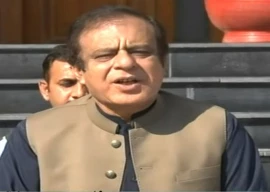
LAHORE:
Officials of the Kasur Tanneries Waste Management Agency, the Environment Protection Department and the Kasur DCO agreed, in a meeting held last week, to channel funds for building a secondary treatment plant to treat the wastewater generated by the tanneries.
They also agreed to pursue a project that would treat the municipal waste being disposed of in River Sutlej.
Currently, there is a primary treatment plant in Kasur. Set up in 2000 – with funds from the United Nations, the Punjab government and KTWMA – it treats about 13,000 of the 18,000 cubic metre wastewater generated daily by about 237 tanneries and associated units.
This plant, however, does not remove heavy metals like chromium from the wastewater. The treated water does not meet the National Environmental Quality Standards (NEQS) adopted under the Punjab Environment Protection Act 2012 and thus remains unfit for human consumption. The project was supposed to later include a secondary plant, to remove heavy metals from the wastewater that has not been set up so far.
According to an agency report and the project director, the treated water also exceeds the permissible bio-chemical oxygen demand (BOD) and chemical oxygen demand (COD). Shabi Hassan, the project director since 2009 and also in charge of setting up the secondary plant, told The Express Tribune that the primary plant lowers the COD to 450 and BOD to 280 to 300 mg/l. According to the NEQS the levels should not exceed 150 and 80 mg/l, respectively.
A report prepared by the KTWMA says that after treatment, 65 per cent of pollutants are removed. The COD and BOD levels of the treated water come to about 1,100 and 650 mg/l, it says.
Hassan said that before the primary plant was set up, the wastewater had affected about 325 acres of land, which has been reclaimed for agricultural.
Hassan said that they had requested the environment secretary to request the Planning and Development Department to release the Rs142 million approved for the project in 2009. According to an estimate in 2004, the secondary plant would cost about Rs800 million. “We were pondering over options for import at the time. But new options are available within Pakistan to set up the plant at a lower cost,” he said.
Hassan is confident the plant can be set up by mid-2014 if the funds are released by June or July this year. The project manager told The Express Tribune that they were also planning to expand the primary treatment plant so that all 18,000 cubic metres of wastewater can be treated.
He said that a fat extracting unit, set up last month with the help of the United Nations Industries and Development organization (UNIDO), was in its trial run. The unit removes fat from the wastewater.
EPA Secretary Sher Alam Mehsud described the secondary plant as “department’s priority”. “I worked in Kasur in 1994 as an assistant commissioner and I know the problems caused there by the pollution,” he said. Mehsud told The Express Tribune that the tannery owners would be asked to pay the difference if the project cost exceeded the approved Rs142 million. “The government is not causing the pollution. They are and they must pay for it,” he said.
Published in The Express Tribune, March 29th, 2013.




































1713509570-0/Taylor-Swift-Album-Release-(1)1713509570-0-270x192.webp)















COMMENTS
Comments are moderated and generally will be posted if they are on-topic and not abusive.
For more information, please see our Comments FAQ